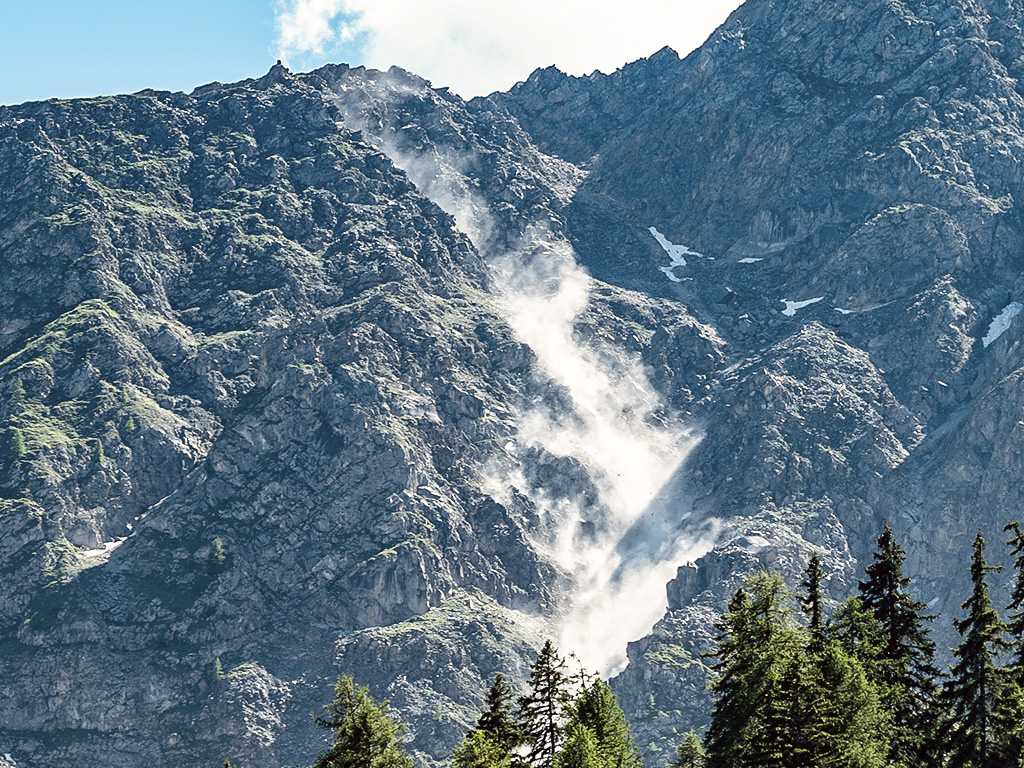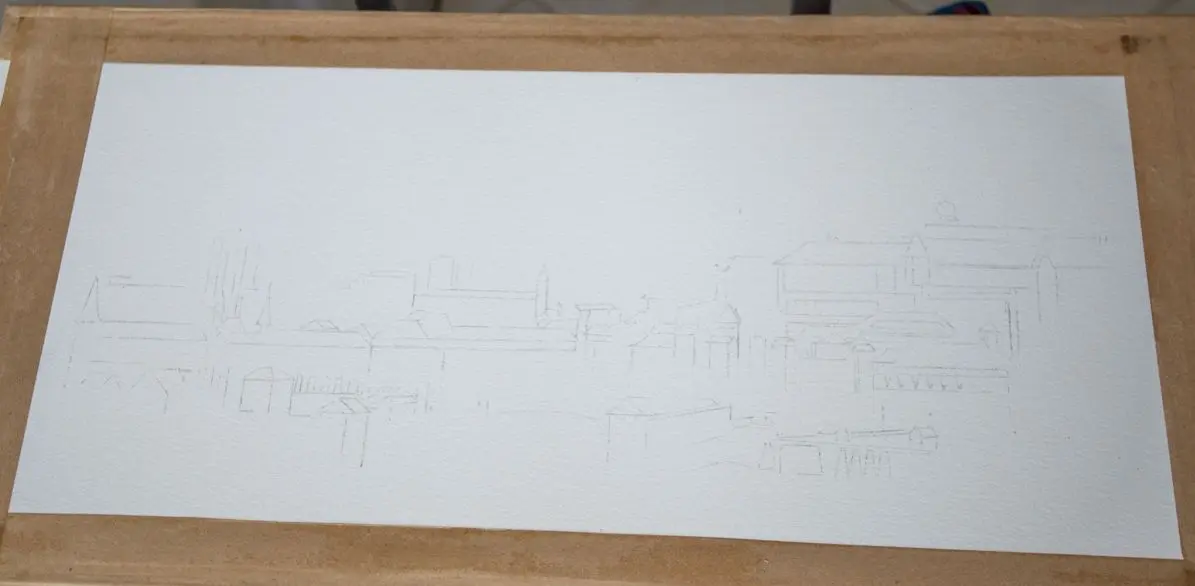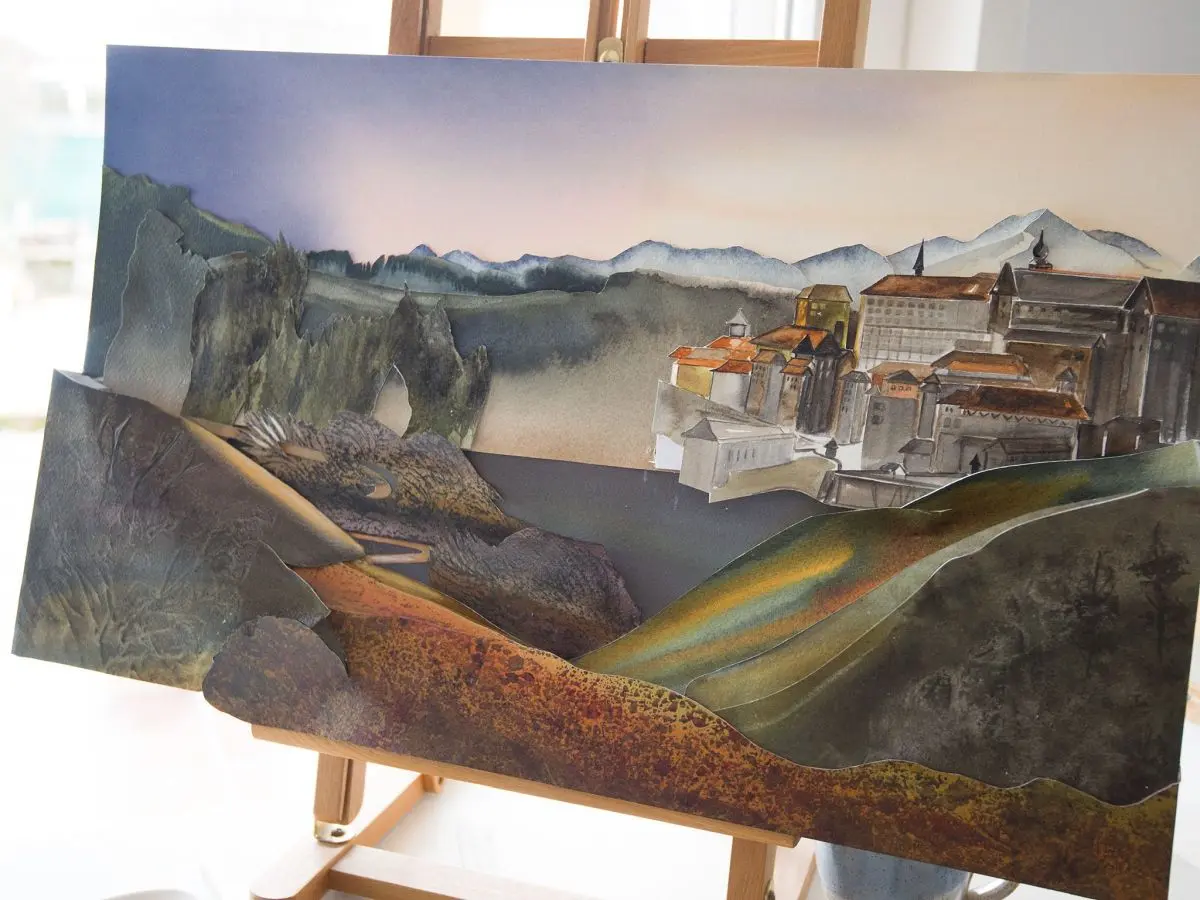Inspiration: The Heart of it All
How Real-World Experiences Shape Every Painting
“I physically have to experience the landscape—taking in the effects, the nuances of colour, the textures of the rock. Even if I paint from memory later, the sensation of being there is what drives the work.”
— Prue Bishop
Every painting begins with an experience. Unlike traditional watercolourists who often work from photographs, Prue Bishop’s sculptural watercolours are deeply rooted in real-world observation, physical engagement, and research.
1️⃣ Experiencing Landscapes Firsthand
Prue believes that to capture a landscape authentically, she must be in it—observing how the light moves, how the colours shift with the seasons, and how depth and texture define the environment.
Example: The Chartreuse Mountains
When painting the Chartreuse region in France, Prue was so struck by the intensity of green hues that she physically gathered armfuls of vegetation. The next day, she mixed every possible shade of green, creating a palette that was true to the landscape.

2️⃣ When Direct Experience Isn’t Possible: Research-Based Inspiration
While Prue prefers firsthand observation, some landscapes—like the Arctic glaciers—are impossible to visit. In these cases, her process involves deep research to maintain accuracy and authenticity.
How She Studies Remote Locations:
✔ Scientific reports & National Geographic articles
✔ Google Earth for accurate topographical perspectives
✔ Historical expedition logs & archival maps
Example: Greenland’s Melting Glaciers
To paint the rapidly disappearing ice formations of Greenland, Prue analyzed satellite imagery to understand how the ice sheets fractured over time. The painting reflects these shifts, translating scientific data into an emotional visual record.
3️⃣ From Inspiration to Artwork: How an Idea Becomes a Painting
Once inspired, Prue begins the long transformation process—from sketches to sculptural depth. This journey involves multiple stages, ensuring each painting captures the essence of its landscape.

1️⃣ Field sketches & notes (example: a quick alpine sketch)
2️⃣ Watercolour studies (example: multiple attempts to capture perspective)
3️⃣ Choosing the right perspective & composition (example: thumbnail studies)
4️⃣ Final sculptural painting (example: side-by-side comparison)
🔗 See How This Becomes a Sculptural Painting →
4️⃣ Conclusion
Every sculptural watercolour has a story behind it—whether it’s shaped by firsthand experience or deep research. The goal is not just to create beauty, but to preserve the essence of a landscape, capturing moments in time before they change forever.

✅ Learn More About the Creative Process
✅ Browse the Collections: France, Switzerland and Global Warming
Inspiration: Das Herzstück jedes Werks
Wie echte Erlebnisse jedes Gemälde formen
“Ich muss die Landschaft physisch erleben – die Wirkungen spüren, die Farbnuancen sehen, die Beschaffenheit des Gesteins fühlen. Selbst wenn ich später aus dem Gedächtnis male, ist das Erleben vor Ort die treibende Kraft meiner Arbeit.”
— Prue Bishop
Jedes Gemälde beginnt mit einem Erlebnis.
Im Gegensatz zu traditionellen Aquarellkünstlern, die oft nach Fotografien arbeiten, sind Prue Bishops skulpturale Aquarelle tief in der realen Beobachtung, körperlichen Erfahrung und sorgfältiger Recherche verwurzelt.
1️⃣ Landschaften mit allen Sinnen erleben
Prue ist überzeugt: Um eine Landschaft authentisch wiederzugeben, muss sie mittendrin sein – das Licht beobachten, Farbwechsel im Jahreslauf wahrnehmen, Tiefe und Struktur spüren.
Beispiel: Die Chartreuse-Berge
In Frankreich war Prue so beeindruckt von den Grüntönen der Chartreuse-Region, dass sie ganze Bündel Pflanzen sammelte. Am nächsten Tag mischte sie jede mögliche Schattierung, um die Farbpalette des Ortes originalgetreu nachzubilden.

2️⃣ Wenn ein Ort unerreichbar ist: Forschung als Inspiration
Manche Orte – wie arktische Gletscher – lassen sich nicht besuchen. In solchen Fällen recherchiert Prue intensiv, um Genauigkeit und Authentizität zu wahren.
Ihre Methoden:
✔ Wissenschaftliche Berichte & Artikel von National Geographic
✔ Google Earth für topografische Perspektiven
✔ Historische Expeditionstagebücher & Karten
Beispiel: Grönlands schmelzende Gletscher
Für ihr Werk über Grönlands schwindendes Eis analysierte Prue Satellitenbilder, um die Brüche der Eisschollen im Zeitverlauf nachzuvollziehen – und übersetzte diese Daten in ein visuelles, emotionales Zeugnis.
3️⃣ Vom Impuls zum Kunstwerk
Jede Inspiration durchläuft einen langen Prozess – vom ersten Skizzenbuch bis zur fertigen Skulpturalen Aquarellarbeit.

1️⃣ Feldskizzen und Notizen (z. B. alpiner Schnellsketch)
2️⃣ Aquarellstudien (mehrere Perspektivversuche)
3️⃣ Kompositionswahl (Thumbnail-Studien)
4️⃣ Endgültiges Skulpturales Gemälde (Vergleich Vorstudie/Finalbild)
🔗 So wird daraus ein Skulpturales Gemälde
4️⃣ Fazit
Hinter jedem Werk steht eine Geschichte – ob erlebt oder erforscht. Prues Ziel ist es, nicht nur Schönheit zu schaffen, sondern den Wandel der Landschaften sichtbar zu machen, bevor sie verschwinden.

✅ Mehr zum künstlerischen Prozess erfahren
✅ Kollektionen entdecken: Frankreich, Schweiz, Klima im Wandel
Inspiration : Au cœur de chaque œuvre
Comment l’expérience réelle façonne chaque peinture
« Je dois ressentir le paysage physiquement – observer les effets, percevoir les nuances, toucher les textures de la roche. Même si je peins de mémoire, c’est cette sensation vécue qui guide mon travail. »
— Prue Bishop
Chaque peinture commence par une expérience.
Contrairement aux aquarellistes traditionnels qui travaillent souvent à partir de photos, les aquarelles sculpturales de Prue Bishop sont profondément ancrées dans l’observation directe, l’engagement physique et la recherche approfondie.
1️⃣ Vivre les paysages de l’intérieur
Pour Prue, peindre un lieu, c’est d’abord le ressentir : la lumière changeante, les couleurs des saisons, la profondeur du relief.
Exemple : Les montagnes de la Chartreuse
Lors d’un séjour dans le massif de la Chartreuse, Prue fut saisie par l’intensité des verts. Elle ramassa des plantes sur place, puis recréa une palette fidèle au paysage.

2️⃣ Quand l’expérience directe est impossible : la recherche comme boussole
Certains lieux, comme les glaciers arctiques, ne sont pas accessibles. Dans ce cas, Prue mène des recherches poussées pour garantir l’exactitude de ses œuvres.
Ses sources :
✔ Rapports scientifiques et articles de National Geographic
✔ Google Earth pour les perspectives topographiques
✔ Journaux d’expédition et cartes anciennes
Exemple : Les glaciers fondants du Groenland
À partir d’images satellites, Prue a retracé les ruptures de la glace dans le temps – transformant les données en une peinture émotionnelle et scientifique à la fois.
💡 "Les œuvres basées sur une expérience personnelle portent une connexion émotionnelle plus profonde, tandis que les peintures issues de recherches sont un voyage intellectuel."
3️⃣ De l’inspiration à l’œuvre finale
Une fois inspirée, Prue entame un long processus : croquis, essais, choix de perspective, puis réalisation de l’œuvre en Sculptural Watercolour®.

Étapes clés :
- Croquis sur le terrain (ex : dessin alpin rapide)
- Études à l’aquarelle
- Choix de la composition (mini croquis)
- Œuvre finale en relief (comparaison avant/après)
🔗 Voir comment une peinture prend forme
4️⃣ Conclusion
Chaque peinture raconte une histoire – vécue ou découverte. L’objectif de Prue : préserver l’essence d’un paysage, en capturant des instants voués à disparaître.

✅ Découvrir le processus créatif
✅ Explorer les collections : France, Suisse, Réchauffement climatique